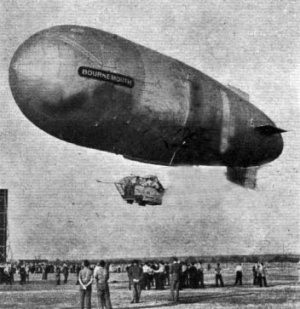He was one of three brothers who all served in the Royal Flying Corps, but very little is known about his war service.
Commercial airship pilot
Known in civilian life as Captain J A Beckford Ball, and so-named on his gravestone in the parish cemetery of St Ouen in Jersey, he was in the headlines in 1930, when he piloted a commercial airship intended to provide an aerial advertising billboard, and again in 1951 when he piloted ‘’Bournemouth’’, the first British airship to be built since the ill-fated R100 and R101.
Captain Beckford Ball was born in 1897 in St Neotts, Huntingdonshire, the middle son of Beckford Ball of Gillingham, Kent, and Florence Malden. His elder brother Brian was born in 1894, and presumably joined the Royal Flying Corps as soon as war broke out, to be followed by John, and eventually by their younger brother Eric, born in 1901. Their father was the manager of a chalk quarry in Kent.
After the war ended Captain Beckford Ball continued his involvement with airships and was chosen to pilot EAD1, the only airship in England at the time apart from the Government’s R100 and R101. He was in charge of the crew of three when, as the ‘’Dover Express’’ recorded, the craft was flown from the north-east of England to Dover.
Advertising
Owned by the Airship Development Company it was intended to provide a new form of advertising, using the side of the airship as a giant billboard flying slowly at a low level over its advertiser's cachment area.
On its first operational flight in May 1930 Capt Ball took the low flying to far and was fined two guineas for flying too low over a farm, causing a frightened horse to bolt and be seriously injured.
The company was based in Cramlington, near Newcastle, using one of the few airship hangars that had survived the First World War. Although nowhere near the size of the R100 and R101, it was, nevertheless, 140 feet long and held 70,000 cubic feet of gas.
Its first operational flight was on behalf of Water Willson’s supermarket chain, carrying the slogan Walter Willson’s on Top.
It was then decided to move the craft to the south of the country, where larger connurbations would support better advertising revenue. A publicity trip around Big Ben and St Paul's proved irresistible but the crew got into difficulties.
A cable snagged, jamming the controls, and one of the men had to climb out of the gondola to try to manually steer the rudder while the engine started to splutter and threaten to cut out. Despite this and several other setbacks they landed a contract with a tobacco firm to fly over Belgium.
Disaster strikes
By coincidence they had just arrived on the continent when the large British airship, the R101, attempted to make its first long distance journey to India. As it crossed northern France disaster struck. The crash of the prestigious airship shocked the nation. There were mechanical problems, but it had also encountered stormy weather which two days later would claim the EAD 1.
It was torn from its moorings and the envelope was ripped by neighbouring trees. With no income coming in and no prospect of surviving through to the following summer, the Airship Development Company called it a day.
Bournemouth
In 1951 Capt Ball was called on to pilot the first British airship built since the R101, when the Bournemouth took to the air as part of RAF Hendon's 50th anniversary celebrations.
Some time later - we are not sure exactly when - Capt Ball and his wife retired to Jersey.


